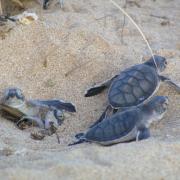June 28, 2013
Increasingly, governments are seeking to consider public as well as expert preferences in decision-making processes relating to environmental policy.
This raises issues about whether public and expert preferences for the environment are aligned, and whether social values, when represented qualitatively, can be effectively weighed in decisions about where to direct funding for environmental management.
What does the community think of marine protection priorities provided to policy and decision-makers by ‘experts’?
A team at the University of Western Australia’s Centre for Environmental Economics and Policy has used an economic modelling methodology called non-market valuation to quantitatively estimate peoples’ environmental values, such as how much they would be willing to pay for protecting biodiversity.
Online questionnaires were used to survey a representative sample of the WA population, and marine scientists. The questions related to environmental values at Ningaloo Marine Park and Ngari Capes Marine Park in Western Australia.
The methodology used hypothetical policy options and costs, and statistical analyses, to work out how much people are willing to pay to protect marine biodiversity.
They found that for Ningaloo, members of the general community held similar values as experts in relation to different marine species. For example, coral and other functional species were highly valued by both groups.
For Ngari Capes, however, the community members valued iconic species such as whales highly, while experts were more interested in functional attributes such as seagrass.
Team member, Abbie Rogers, said that while further work was needed to confirm the reasons for the difference in preferences, a tentative conclusion was that awareness and knowledge had a bearing. While the Ningaloo system had been well promoted, the Ngari Capes was not so well known.
The team is now using similar methodologies to look at community preferences Australia-wide in relation to marine biodiversity offset policies.
“A lot of science is involved in applying offsets, but the policies do not necessarily represent community preferences,” Dr Rogers said.
“We are looking at what people think about the notion of biodiversity offsetting, including the concept of replacing like-for-like as a conservation approach, compared to implementing compensatory research.”
Dr Rogers said the research and the methodology would help policy and decision-makers to get a broader indication of the views of the community, rather than just vocal stakeholders.
It would also enable community perceptions to be fully accounted for in policy-making and when weighing the benefits of an environmental project.
Images
The study used survey-based techniques to determine how much the West Australian community would be willing to pay to protect marine biodiversity, including turtle populations in the Ningaloo Marine Park. (Image: Chloe Sykes)

For Ningaloo, members of the general community held similar values as experts in relation to different marine species. (Image: CSIRO)

Further reading
A.A. Rogers. (2013) Public and expert preference divergence: evidence from a choice experiment of marine reserves in Australia. Land Economics
A.A. Rogers. (2013) Social welfare and marine reserves – is willingness to pay for conservation dependent on management process? A discrete choice experiment of the Ningaloo Marine Park in Australia Canadian Journal of Agricultural Economics
Contact
Dr Abbie Rogers, University of Western Australia
- Log in to post comments
